Bedworth was created largely in Victorian times, as a result of weaving and coal-mining. The town centre was comprehensively redeveloped in the 1960s and early 1970s, when the centuries-old and well-known King’s Head, at the top end of King Street, and the Old Pheasant, a little further down, both disappeared. So, too, did Bedworth’s status as an urban district, in Warwickshire. The Bear and Ragged Staff is the county emblem of Warwickshire and also the name of a public house swept away in the redevelopment of Bedworth’s town centre, but the name lives on in this Wetherspoon pub.
A photograph and text about Lady Godiva.
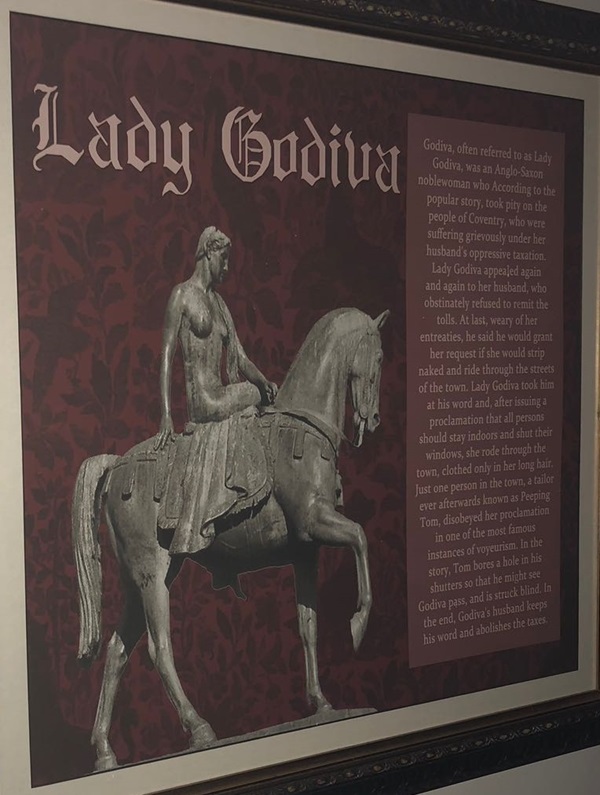
The text reads: Godiva, often referred to as Lady Godiva, was an Anglo-Saxon noblewoman who According to the popular story, took pity on the people of Coventry, who were suffering grievously under her husband’s oppressive taxation. Lady Godiva appealed again and again to her husband, who obstinately refused to remit the tolls. At last, weary of her entreaties, he said he would grant her request if she would strip naked and ride through the streets of the town. Lady Godiva took him at his word and after issuing a proclamation that all persons should stay indoors and shut their windows, she rode through the town, clothed only in her long hair.
Just one person in the town, a tailor ever afterwards known as Peeping Tom, disobeyed her proclamation in one of the most famous instances of voyeurism. In the story, Tom bored a hole in his shutters so that he might see Godiva pass, and it struck blind. In the end, Godiva’s husband keeps his word and abolishes the taxes.
Photographs, illustrations and text about the three rectors.
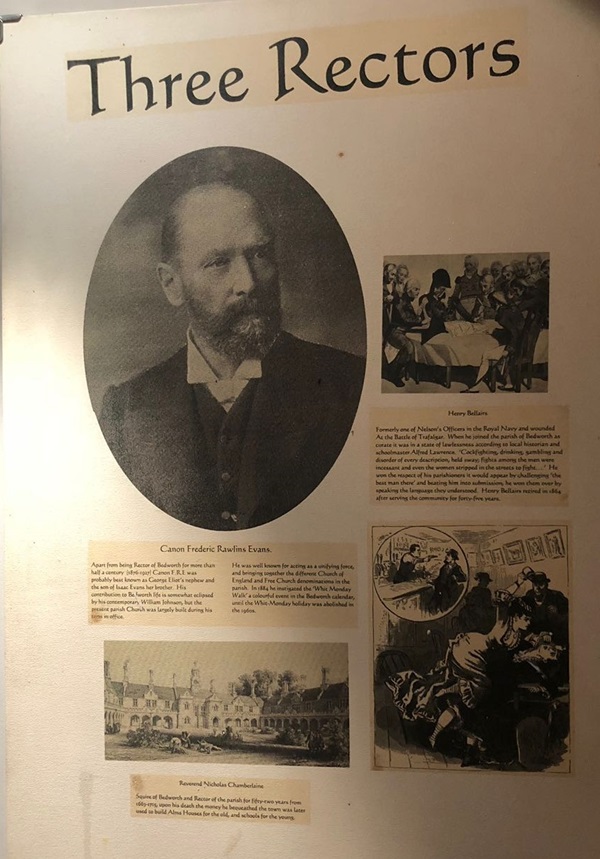
The text reads: Henry Bellairs
Formerly one of Nelson’s Officers in the Royal Navy and wounded at the Battle of Trafalgar. When he joined the parish of Bedworth as curate it was in a state of lawlessness according to local historian and schoolmaster Alfred Lawrence. ‘Cockfighting, drinking, gambling and disorder of every description, held sway; fights among the men were incessant and even the women stripped in the streets to fight…’ He won the respect of his parishioners it would appear by challenging ‘the best man there’ and beating him into submission, he won them over by speaking the language they understood. Henry Bellairs retired in 1864 after serving the community for forty-five years.
Canon Frederic Rawlins Evans
Apart from being Rector of Bedworth for more than half a century (1876-1927) Canon FRE was probably best known as George Eliot’s nephew and the son of Isaac Evans her brother. His contribution to Bedworth life is somewhat eclipsed by his contemporary William Johnson, but the present parish Church was largely built during his term in office.
He was well known for acting as a unifying force, and bringing together the different Church of England and Free Church denominations in the parish. In 1884 he instigated the ‘Whit Monday Walk’ a colourful event in the Bedworth calendar, until the Whit-Monday holiday was abolished in the 1960s.
Reverend Nicholas Chamberlain
Squire of Bedworth and Rector of the parish for fifty two years from 1663-1715, upon his death the money he bequeathed the town was later used to build Alms Houses for the old, and schools for the young.
Illustrations and text about industries in Bedworth.
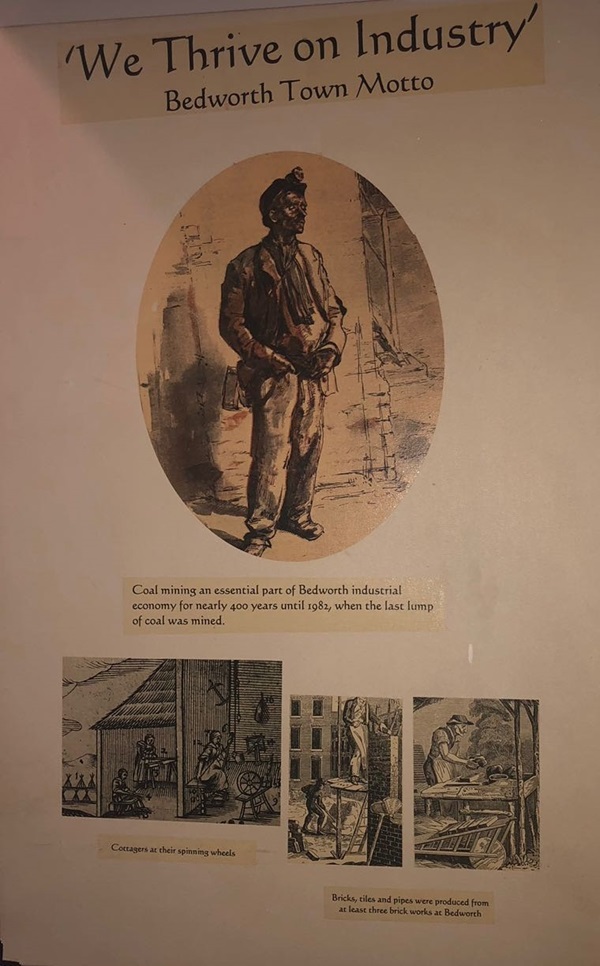
The text reads: ‘We Thrive on Industry’ – Bedworth town motto.
Coal mining was an essential part of Bedworth industrial economy for nearly 400 years until 1982, when the last lump of coal was mined.
Cottages at their spinning wheels
Bricks, tiles, and pipes were produced from at least three brick works at Bedworth.
A prints and text about Mary Anne Evans.
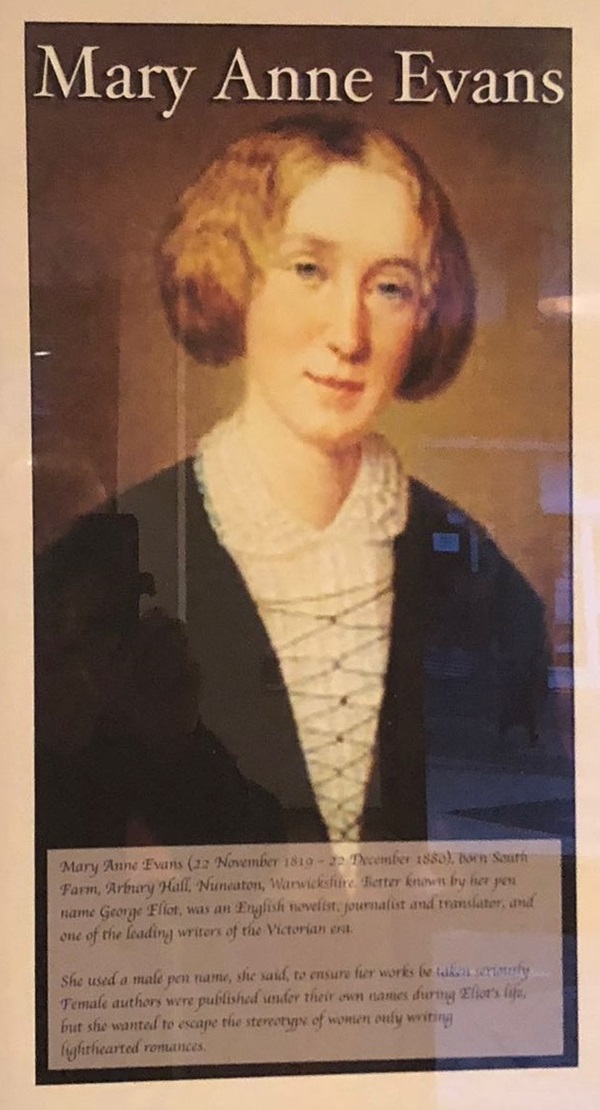
The text reads: Mary Anne Evans (22 November 1819 – 22 December 1880), born South Farm, Arbury Hall, Nuneaton, Warwickshire. Better known by her yen name George Eliot, was an English novelist, journalist and translator, and one of the leading writers of the Victorian era.
She used a male pen name, she said, to ensure her works be taken seriously. Female authors were published under their own names during Eliot’s life, but she wanted to escape the stereotype of women only writing light-hearted romances.
A photograph and text about Nick Skelton.
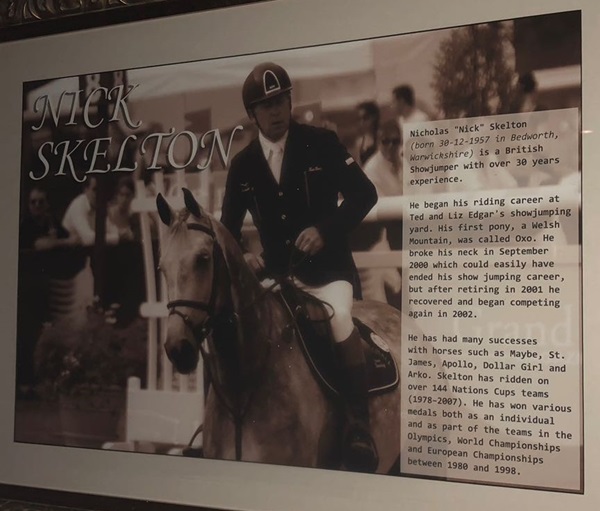
The text reads: Nicholas “Nick” Skelton (born 30-12-1957 in Bedworth, Warwickshire) is a British Showjumper with over 30 years’ experience.
He began his riding career at Ted and Liz Edgar’s show jumping yard. His first pony, a Welsh Mountain, was called Oxo. He broke his neck in September 2000 which could easily have ended his show jumping career, but after retiring in 2001 he recovered and began competing again in 2002.
He has had many successes with horses such as Maybe, St. James, Apollo, Dollar Girl and Arko. Skelton has ridden on over 144 Nations Cups teams (1978-2007). He has won various medals both as an individual and as part of the teams in the Olympics, World Championships between 1980 and 1998.
A photograph and text about Arthur Hutt VC.
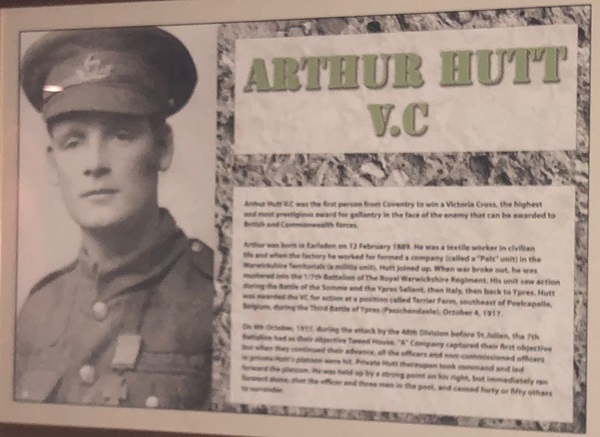
The text reads: Arthur Hutt VC was the first person from Coventry to win a Victoria Cross, the highest and most prestigious award for gallantry in the face of the enemy that can be awarded to British and Commonwealth forces.
Arthur was born in Earlsdon on 12 February 1889. He was a textile worker in civilian life and when the factory he worked for formed a company (called a “Pals” unit) in the Warwickshire Territorials (a militia unit), Hutt joined up. When war broke out, he was mustered into the 1/7th Battalion of The Royal Warwickshire Regiment. His unit saw action during the Battle of the Somme and the Ypres Salient, then Italy, then back to Ypres. Hutt was awarded the VC for action at a position called Terrier Farm, southeast of Poelcapelle, Belgium, during the Third Battle of Ypres (Passchendaele), October 4, 1917.
On 4 October, 1917, during the attack by the 48th Division before St. Julien, the 7th Battalion had as their objective Tweed House. “A” Company captured their first objective but when they continued their advance, all the officers and non-commissioned officers in private Hutt’s platoon were hit. Private Hutt thereupon took command and led forward the platoon. He was held up by a strong point on his right, but immediately ran forward along, shot the officer and three men in the post, and caused forty or fifty others to surrender.
Photographs and text about Stubbs’ Toy Shop.
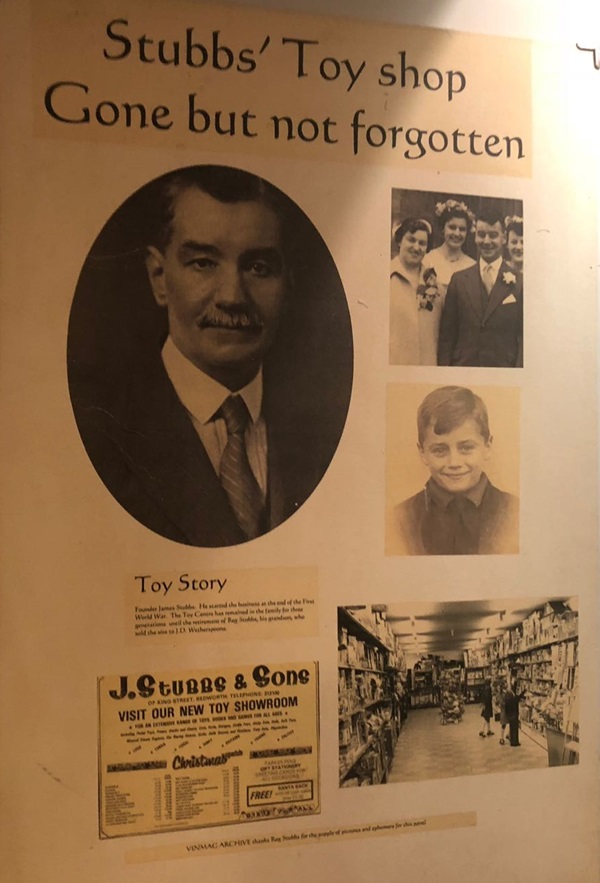
The text reads: Founder James Stubbs. He started the business at the end of the First World War. The Toy Centre has remained in the family for three generations, until the retirement of Reg Stubbs, his grandson, who sold the site to J D Wetherspoon.
A photograph and text about St Francis of Assisi Roman Catholic Church.
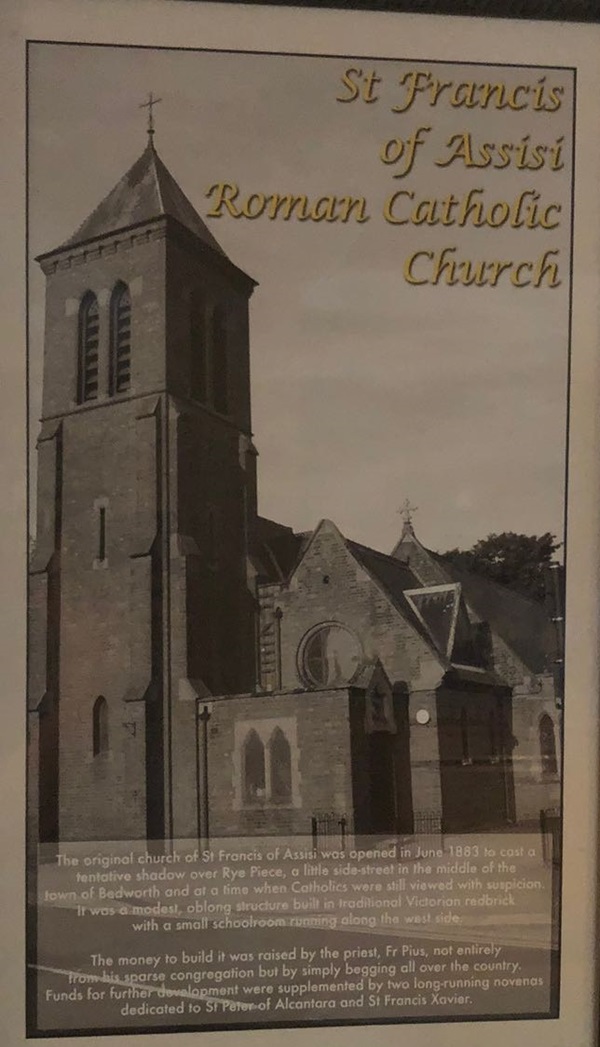
The text reads: The original church of St Francis of Assisi was opened in June 1883 to cast a tentative shadow over Rye Piece, a little side-street in the middle of the town of Bedworth and at a time when Catholics were still viewed with suspicion. It was a modest, oblong structure built in tradition Victorian redbrick with a small schoolroom running along the west side.
The money to build it was raised by the priest, Fr Pious, not entirely from his sparse congregation but by simply begging all over the country. Funds for further development were supplemented by two long-running novenas dedicated by St Peter of Alcantara and St Francis Xavier.
Illustrations and text about the Huguenots.
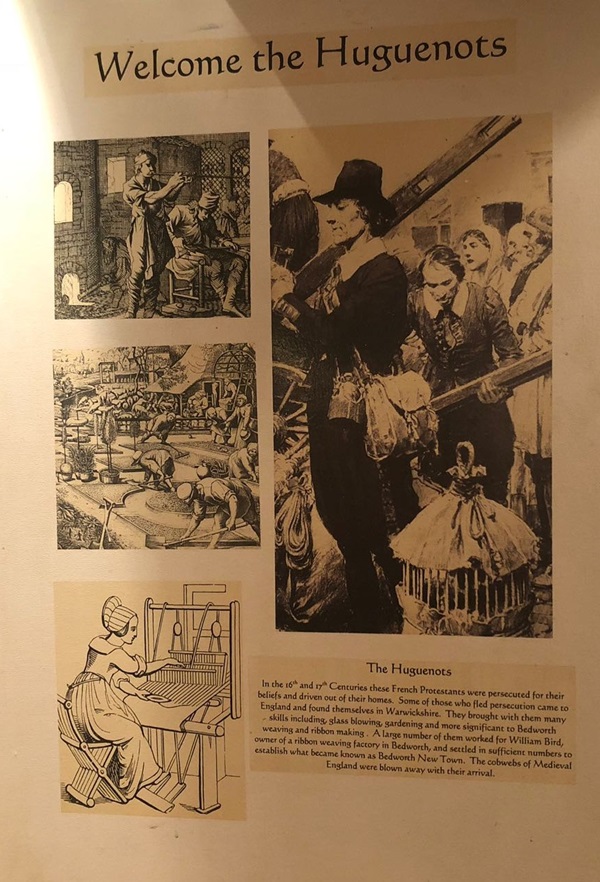
The text reads: In the 16th and 17th centuries these French Protestants were persecuted for their beliefs and driven out of their homes. Some of those who fled persecution came to England and found themselves in Warwickshire. They brought with them many skills including, glass blowing, gardening and more significantly to Bedworth weaving and ribbon making. A large number of them worked for William Bird, owner of a ribbon weaving factory in Bedworth, and settled in sufficient numbers to establish what became known as Bedworth New Town. The cobwebs of Medieval England were blown away with their arrival.
Illustrations and text about women weavers of Bedworth.
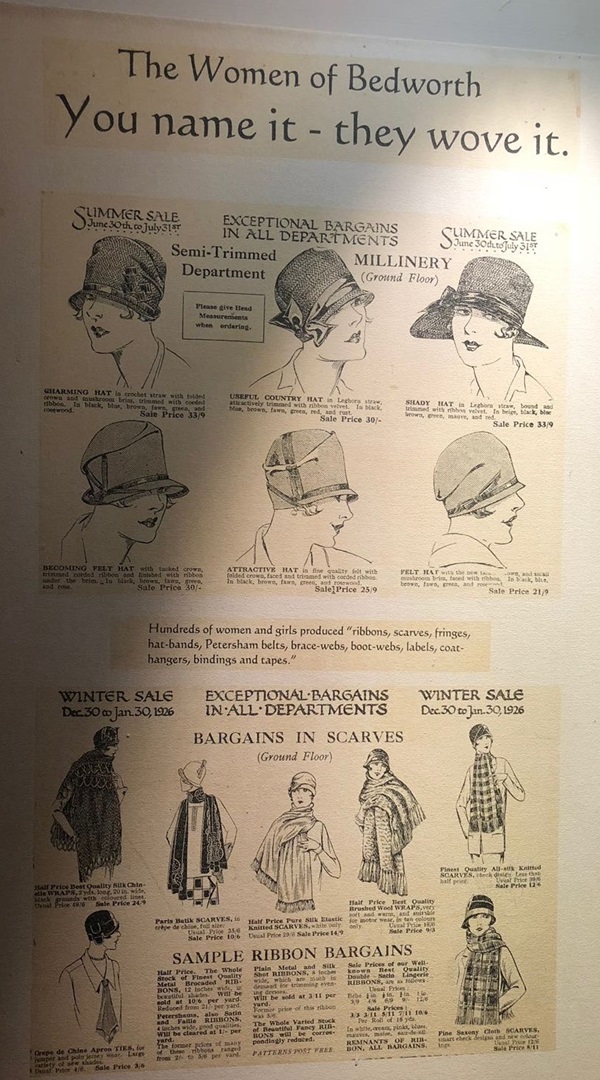
The text reads: Hundreds of women and girls produced ribbons, scarves, fringes, hat-bands, Petersham belts, brace-webs, boot-webs, labels, coat-hangers, bindings and tapes.
Photographs and text about George Elliot.
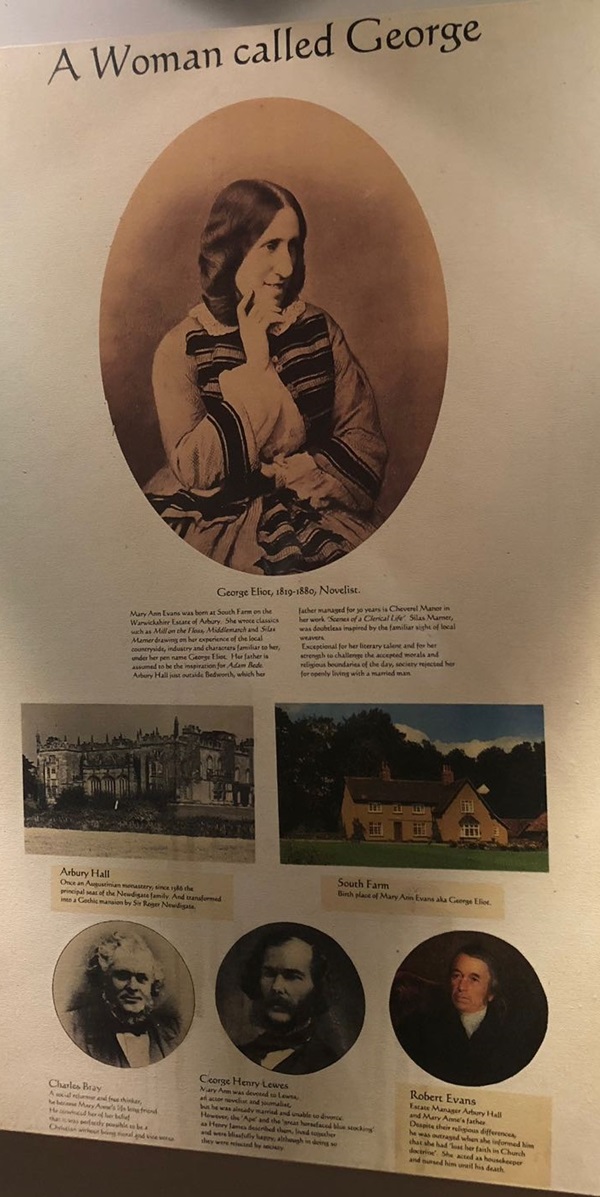
The text reads: Mary Ann Evans was born at South Farm on the Warwickshire Estate of Arbury. She wrote classics such as Mill on the Floss, Middlemarch and Silas Marner drawing on her experience of the local countryside, industry and characters familiar to her, under her pen name George Eliot. Her father is assumed to be the inspiration for Adam Bede. Arbury Hall just outside Bedworth, which her father managed for 30 years is Cheverel Manor in her work ‘Scenes of a Clerical Life’. Silas Marner, was doubtless inspired by the familiar sight of local weaves.
Exceptional for her literary talent and for her strength to challenge the accepted morals and religious boundaries of the day, society rejected her for openly living with a married man.
Photographs and text about Billy Johnson.
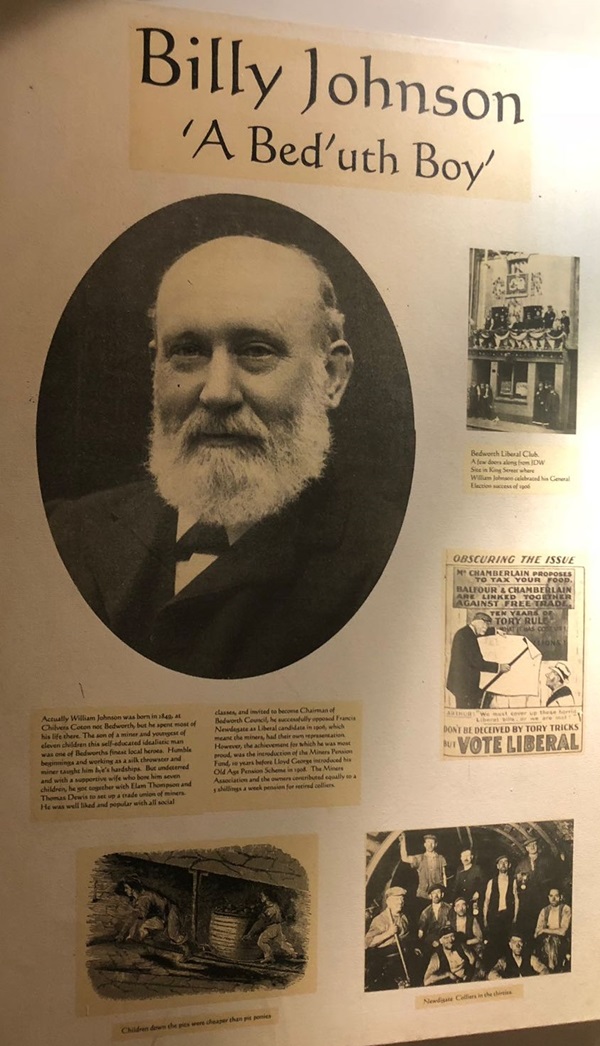
The text reads: Actually William Johnson was born in 1849, at Chilvers Coton not Bedworth, but he spent most of his life there. The son of a miner and youngest of eleven children this self-educated idealistic man was one of Bedworth’s finest local heroes. Humble beginnings and working as a silk throwster and miner taught him life’s hardships. But undeterred and with a supportive wife who bore him seven children, he got together with Elam Thompson and Thomas Dewis to set up a trade union of miners. He was well liked and popular with all social classes, and invited to become Chairman of Bedworth Council, he successfully opposed Francis Newdegate as Liberal candidate in 1906, which meant the miners, had their own representation, However, the achievement for which he was most proud, was the introduction of the Miners Pension Fund, 10 years before Lloyd George introduced his Old Age Pension Scheme in 1908. The Miners Association and the owners contributed equally to a 5 shillings a week pension for retired colliers.
Illustrations and text about Bedworth pastimes.
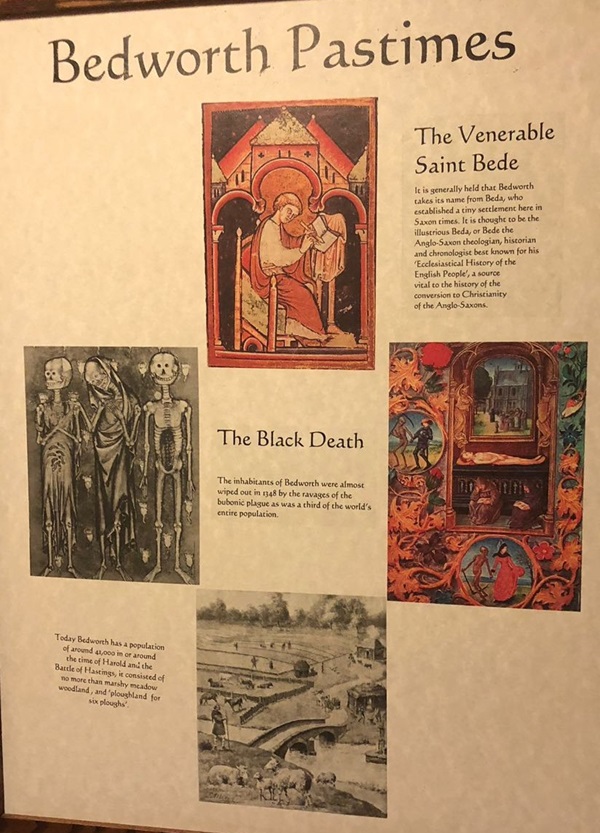
The text reads: The Venerable Saint Bede
It is generally held that Bedworth takes its name from Beda, who established a tiny settlement here in Saxon times. It is thought to be the illustrious Beda, or Bede the Anglo-Saxon theologian, historian and chronologist best known for his ‘Ecclesiastical History of the English People’, a source vital to the history of the conversion to Christianity of the Anglo-Saxons.
The Black Death
The inhabitants of Bedworth were almost wiped out in 1348 by the ravages of the bubonic plague as was a third of the world’s entire population.
External photograph of the building – main entrance.
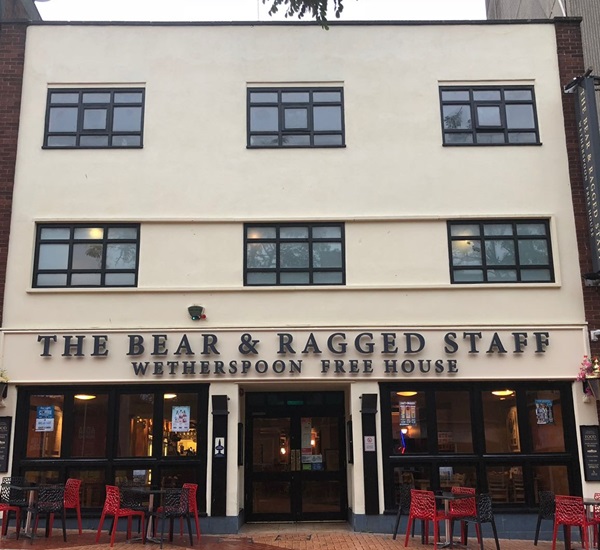
If you have information on the history of this pub, then we’d like you to share it with us. Please e-mail all information to: pubhistories@jdwetherspoon.co.uk